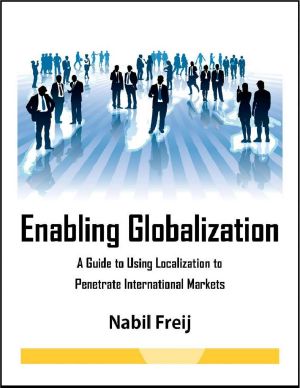Enabling Globalization · A Guide to Using Localization to Penetrate International Markets

- Authors
- Freij, Nabil
- Publisher
- Smashwords Edition
- Tags
- international , language , marketing , translation , localization , machine translation , globalization , software , management , business , quality assurance , technology
- ISBN
- 9780615348537
- Date
- 2010-02-19T00:00:00+00:00
- Size
- 1.82 MB
- Lang
- en
We’ve built this guide because despite the need, nothing like it exists: a concise, step-by-step handbook for globalization and localization in the new millennium.
Companies come to us with a desire to go global but unsure of what the process entails. Some face a Catch-22 dilemma. They want to penetrate international markets, but cannot justify the associated costs.
Others – some who have been selling overseas and localizing for years – want to know more about the new tools and processes that will improve both their results and their bottom line.
Welcome to Enabling Globalization: A Guide to Using Localization to Penetrate International Markets. Here you will find the practical advice you need to start on your way and follow through to a successful global release of your products or website.
First, consider this: Of the US’s top 10 trading partners, 1.9 billion of these nations’ consumers don’t speak English. So, does that mean that your solution is to hire a translator? No. Simply translating your products, documentation, and/or website isn’t enough to make them accessible to international customers. Translation is merely changing words from one language to another. Making your product usable and appealing in another culture requires professional localization – adapting it to the local styles, customs, needs, and preferences – and much more.
Also, just because your products are localized, this does not mean that clients will beat a path to your door! Enabling Globalization offers you the essential information you need to accomplish your desired global penetration. Over the course of our 16 years’ experience, we’ve seen how many companies do it and have passed along the knowledge we’ve acquired by offering newsletters and articles covering a wide range of topics related to localization and international releases. Here we compile a selection of them, updated to reflect the latest trends and technologies in a comprehensive guide.
Helpful features make it easy to find just what you need now. Each of the guide’s 27 chapters fall within one of seven parts, from Getting Started to Keeping the Commitment. Going global on a shoestring, best practices, the latest technologies, and special challenges are just a few of the areas of interest explored along the way. We also give you ample links to additional resources on the web.
So, whether you’re just entering the wide world of globalization or you’re a veteran of the field, this guide is for you. We invite you to take a look inside the industry through the eyes of a successful localization company. Enabling Globalization will enlighten and inspire you – and leave you eager to tackle your next international market!This is a must reference for anyone thinking to market products (especially Software) and services globally.
Reader Review:
It's kind of ironic but true - globalization requires localization, and this book has plenty good insights into a process which many times is mistakenly referred to as "translation." Localization obviously requires and entails translation but it's actually a lot more than that. Even if you read only Chapter 2 of this book ( "Localization Myths and Missteps") it'd be worth your modest investment in this unique volume.
In the chapter devoted to "Best Localization Practices", Mr. Freij dives into such important topics as product localization processes, single-sourcing for technical translation, authoring for localization, selecting your in-country reviewers, budgeting the process, and more. That is, Freij approaches the issue not only from the point of view of technical communicators but corporate customers/buyers and project managers as well. That makes this 118-page volume a comprehensive resource indeed.
The cost of localization is also given its own chapter where the author explains best methods to contain budget overruns and ten tips for achieving quality in localization at every budget level.